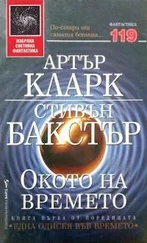Стивен Бакстер - The Good New Stuff
Здесь есть возможность читать онлайн «Стивен Бакстер - The Good New Stuff» весь текст электронной книги совершенно бесплатно (целиком полную версию без сокращений). В некоторых случаях можно слушать аудио, скачать через торрент в формате fb2 и присутствует краткое содержание. Год выпуска: 2002, ISBN: 2002, Издательство: St. Martin's Griffin, Жанр: Фантастика и фэнтези, на английском языке. Описание произведения, (предисловие) а так же отзывы посетителей доступны на портале библиотеки ЛибКат.
- Название:The Good New Stuff
- Автор:
- Издательство:St. Martin's Griffin
- Жанр:
- Год:2002
- ISBN:0-312-26456-9
- Рейтинг книги:3 / 5. Голосов: 1
-
Избранное:Добавить в избранное
- Отзывы:
-
Ваша оценка:
- 60
- 1
- 2
- 3
- 4
- 5
The Good New Stuff: краткое содержание, описание и аннотация
Предлагаем к чтению аннотацию, описание, краткое содержание или предисловие (зависит от того, что написал сам автор книги «The Good New Stuff»). Если вы не нашли необходимую информацию о книге — напишите в комментариях, мы постараемся отыскать её.
The Good New Stuff — читать онлайн бесплатно полную книгу (весь текст) целиком
Ниже представлен текст книги, разбитый по страницам. Система сохранения места последней прочитанной страницы, позволяет с удобством читать онлайн бесплатно книгу «The Good New Stuff», без необходимости каждый раз заново искать на чём Вы остановились. Поставьте закладку, и сможете в любой момент перейти на страницу, на которой закончили чтение.
Интервал:
Закладка:
Before the craft was assigned to me, it was named the Saint Thomas, after the apostle, but I did not consider a saint notorious for doubting to be an appropriate patron for a ship enlisted in the fight against heresy.
I have no duties aboard the Truth, which is crewed by six brothers and sisters of the Order of Saint Christopher the Far-Travelling, and captained by a young woman I hired away from a merchant trader. I was therefore able to devote the entire three-week voyage from Vess to Arion to a study of the heretical Bible, a copy of which had been given to me by the Archbishop's administrative assistant. It was a thick, heavy, handsome book, bound in dark leather, its pages tipped with gold leaf, with many splendid interior illustrations in full color with holographic enhancement. Remarkable work, clearly done by someone who loved the all-but-forgotten art of bookmaking. The paintings reproduced inside— the originals, I gathered, were to be found on the walls of the House of Saint Judas on Arion— were masterful, if blasphemous, as much high art as the Tammerwens and RoHallidays that adorn the Great Cathedral of Saint John on New Rome.
Inside, the book bore an imprimatur indicating that it had been approved by Lukyan Judasson, First Scholar of the Order of Saint Judas Iscariot.
It was called The Way of Cross and Dragon.
I read it as the Truth of Christ slid between the stars, at first taking copious notes to better understand the heresy I must fight, but later simply absorbed by the strange, convoluted, grotesque story it told. The words of text had passion and power and poetry.
Thus it was that I first encountered the striking figure of Saint Judas Iscariot, a complex, ambitious, contradictory, and altogether extraordinary human being.
He was born of a whore in the fabled ancient city-state of Babylon on the same day that the savior was born in Bethlehem, and he spent his childhood in the alleys and gutters, selling his own body when he had to, pimping when he was older. As a youth he began to experiment with the dark arts, and before the age of twenty he was a skilled necromancer. That was when he became Judas the Dragon-Tamer, the first and only man to bend to his will the most fearsome of God's creatures, the great winged fire-lizards of Old Earth. The book held a marvelous painting of Judas in some great dank cavern, his eyes aflame as he wields a glowing lash to keep a mountainous green-gold dragon at bay. Beneath his arm is a woven basket, its lid slightly ajar, and the tiny scaled heads of three dragon chicks are peering from within. A fourth infant dragon is crawling up his sleeve. That was in the first chapter of his life.
In the second, he was Judas the Conqueror, Judas the Dragon-King, Judas of Babylon, the Great Usurper. Astride the greatest of his dragons, with an iron crown on his head and a sword in his hand, he made Babylon the capital of the greatest empire Old Earth had ever known, a realm that stretched from Spain to India. He reigned from a dragon throne amid the Hanging Gardens he had caused to be constructed, and it was there he sat when he tried Jesus of Nazareth, the troublemaking prophet who had been dragged before him bound and bleeding. Judas was not a patient man, and he made Christ bleed still more before he was through was Him. And when Jesus would not answer his questions, Judas contemptuously had Him cast back out into the streets. But first, he ordered his guards to cut off Christ's legs. "Healer," he said, "heal thyself."
Then came the Repentance, the vision in the night, and Judas Iscariot gave up his crown, his dark arts, and his riches to follow the man he had crippled. Despised and taunted by those he had tyrannized, Judas became the Legs of the Lord, and for a year carried Jesus on his back to the far corners of the realm he once ruled. When Jesus did finally heal Himself, then Judas walked at his side, and from that time forth he was Jesus' trusted friend and counselor, the first and foremost of the Twelve. Finally, Jesus gave Judas the gift of tongues, recalled and sanctified the dragons that Judas had sent away, and sent his disciple forth on a solitary ministry across the oceans, "to spread My Word where I cannot go."
There came a day when the sun went dark at noon and the ground trembled, and Judas swung his dragon around on ponderous wings and flew back across the raging seas. But when he reached the city of Jerusalem, he found Christ dead on the cross.
In that moment his faith faltered, and for the next three days the Great Wrath of Judas was like a storm across the ancient world. His dragons razed the Temple in Jerusalem, drove the people forth from the city, and struck as well at the great seats of power in Rome and Babylon. And when he found the others of the Twelve and questioned them and learned of how the one named Simon-called-Peter had three times betrayed the Lord, he strangled Peter with his own hands and fed the corpse to his dragons. Then he sent those dragons forth to start fires throughout the world, funeral pyres for Jesus of Nazareth.
And Jesus rose on the third day, and Judas wept, but his tears could not turn Christ's anger, for in his wrath he had betrayed all of Christ's teachings.
So Jesus called back the dragons, and they came, and everywhere the fires went out. And from their bellies he called forth Peter and made him whole again, and gave him dominion over the Church.
Then the dragons died, and so too did all dragons everywhere, for they were the living sigil of the power and wisdom of Judas Iscariot, who had sinned greatly. And He took from Judas the gift of tongues and the power of healing He had given, and even his eyesight, for Judas had acted as a blind man (there was a fine painting of the blinded Judas weeping over the bodies of his dragons). And He told Judas that for long ages he would be remembered only as Betrayer, and people would curse his name, and all that he had been and done would be forgotten.
But then, because Judas had loved Him so, Christ gave him a boon: an extended life, during which he might travel and think on his sins and finally come to forgiveness. Only then might he die.
And that was the beginning of the last chapter in the life of Judas Iscariot. But it was a very long chapter indeed. Once dragon-king, once the friend of Christ, now he was only a blind traveler, outcast and friendless, wandering all the cold roads of the Earth, living still when all the cities and people and things he had known were dead. Peter, the first Pope and ever his enemy, spread far and wide the tale of how Judas had sold Christ for thirty pieces of silver, until Judas dared not even use his true name. For a time he called himself just Wandering Ju', and afterward many other names. He lived more than a thousand years and became a preacher, a healer, and a lover of animals, and was hunted and persecuted when the Church that Peter had founded became bloated and corrupt. But he had a great deal of time, and at last he found wisdom and a sense of peace, and finally, Jesus came to him on a long-postponed deathbed and they were reconciled, and Judas wept once again. Before he died, Christ promised that he would permit a few to remember who and what Judas had been, and that with the passage of centuries the news would spread, until finally Peter's Lie was displaced and forgotten.
Such was the life of St. Judas Iscariot, as related in The Way of Cross and Dragon.
His teachings were there as well and the apocryphal books he had allegedly written.
When I had finished the volume, I lent it to Arla-k-Bau, the captain of the Truth of Christ.
Arla was a gaunt, pragmatic woman of no particular faith, but I valued her opinion. The others of my crew, the good sisters and brothers of Saint Christopher, would only have echoed the Archbishop's religious horror.
Читать дальшеИнтервал:
Закладка:
Похожие книги на «The Good New Stuff»
Представляем Вашему вниманию похожие книги на «The Good New Stuff» списком для выбора. Мы отобрали схожую по названию и смыслу литературу в надежде предоставить читателям больше вариантов отыскать новые, интересные, ещё непрочитанные произведения.
Обсуждение, отзывы о книге «The Good New Stuff» и просто собственные мнения читателей. Оставьте ваши комментарии, напишите, что Вы думаете о произведении, его смысле или главных героях. Укажите что конкретно понравилось, а что нет, и почему Вы так считаете.











